|
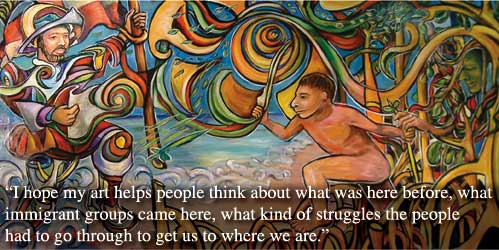
Florida's 2006 Heritage Month
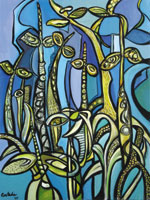 Miami
artist Xavier Cortada sees the past in every concrete-and-steel
vision of the future. As an unprecedented building boom continues to
remake his city, he walks familiar paths and increasingly is left
with the sense of being lost. Miami
artist Xavier Cortada sees the past in every concrete-and-steel
vision of the future. As an unprecedented building boom continues to
remake his city, he walks familiar paths and increasingly is left
with the sense of being lost.
As landmarks vanish and slick new buildings
loom, Cortada focuses on what used to be. "When you walk by a new
building today you can't imagine that in 1914 there was a wooden
shack there. And much less, that 20 years before there was a
mangrove forest. We get stuck in visual constructions. We are so
focused on the here and now and what looks to be concrete that we
forget that history makes the concrete fluid."
Through his art, Cortada attempts to
reclaim Florida's fertile past. The concrete columns that hold up
I-95 through downtown Miami now bear his mark: in 2004, he painted
colorful mangrove seedlings on columns across four neighborhoods, a
metaphoric re-foresting and an invitation to locals to celebrate the
cultural riches that made Miami.
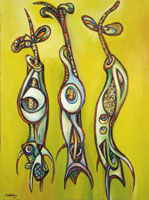 "I
hope my art helps people think about what was here before, what
immigrant groups came here, what kinds of struggles the people had
to go through to get us to where we are. Context is what allows us
to go forward in a sensitive and proactive way. To grow and to not
take a look back is what is problematic." "I
hope my art helps people think about what was here before, what
immigrant groups came here, what kinds of struggles the people had
to go through to get us to where we are. Context is what allows us
to go forward in a sensitive and proactive way. To grow and to not
take a look back is what is problematic."
He has elaborated on the mangrove metaphor
in murals he created for Miami City Hall and the Miami-Dade County
Commission Chambers. Cortada uses mangroves to portray the journey
and interconnectedness of Floridians. "We all come from different
places to make Miami our home, much like a mangrove seedling that
washes up on a Florida sandbar sets roots.
Cortada, who was born in Albany, New York
and grew up in Miami, has exhibited his work in museums, galleries
and cultural venues around the world. He has created art for the
White House, the World Bank, the Miami Art Museum, the Miami-Dade
Juvenile Courthouse and the Miami Children's Museum.
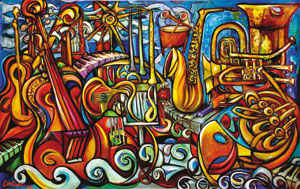 Cortada
is currently working on a painting for the Old Capitol Building in
Tallahassee. He was selected to produce the painting which will
become the 2006 Florida Heritage Month poster, distributed to
schools, museums, libraries, local arts agencies, and state service
organizations throughout the state. Cortada
is currently working on a painting for the Old Capitol Building in
Tallahassee. He was selected to produce the painting which will
become the 2006 Florida Heritage Month poster, distributed to
schools, museums, libraries, local arts agencies, and state service
organizations throughout the state.
Floridians and visitors can see other
Cortada work throughout the state. A series of paintings depicting
landmark U.S. Supreme Court cases originating in Florida are on
long-term loan to the Florida Supreme Court in Tallahassee. And, two
paintings hang in Tallahassee's Museum of Florida History. They were
created to celebrate National Hispanic Heritage Month 2003, when
Governor Bush unveiled the mangrove-themed paintings, one about
Ponce de Leon's 1513 landing on Florida shores and the other about
recent arrivals who came by raft.
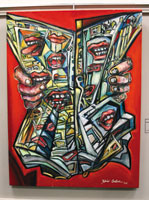 In
March 2005, a solo exhibit on mangroves opened at the capitol's
penthouse gallery and is now touring the state. It will be seen at
the Artel Gallery in Pensacola on February 2006. In
March 2005, a solo exhibit on mangroves opened at the capitol's
penthouse gallery and is now touring the state. It will be seen at
the Artel Gallery in Pensacola on February 2006.
Cortada used mangroves in his portrait of
Florida's first catholic bishop, Augustin Verot. The painting was
transformed into a 16-foot glass mosaic that hangs in the courtyard
of Bishop Verot High School in Fort Myers.
Cortada is also well-known for his
collaborative public art. Major projects include International AIDS
Conference murals in Switzerland and South Africa, peace murals in
Northern Ireland and Cyprus, and child welfare murals in Bolivia and
Panama. Corporations such as Nike, Heineken and Hershey's have
commissioned his art. Publishers like McDougal and Random House have
featured it in school textbooks.
Cortada holds degrees from the University
of Miami College of Arts and Sciences, Graduate School of Business
and School of Law.

|